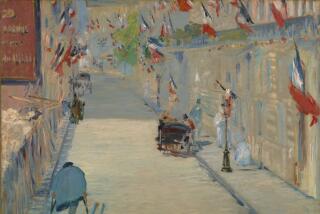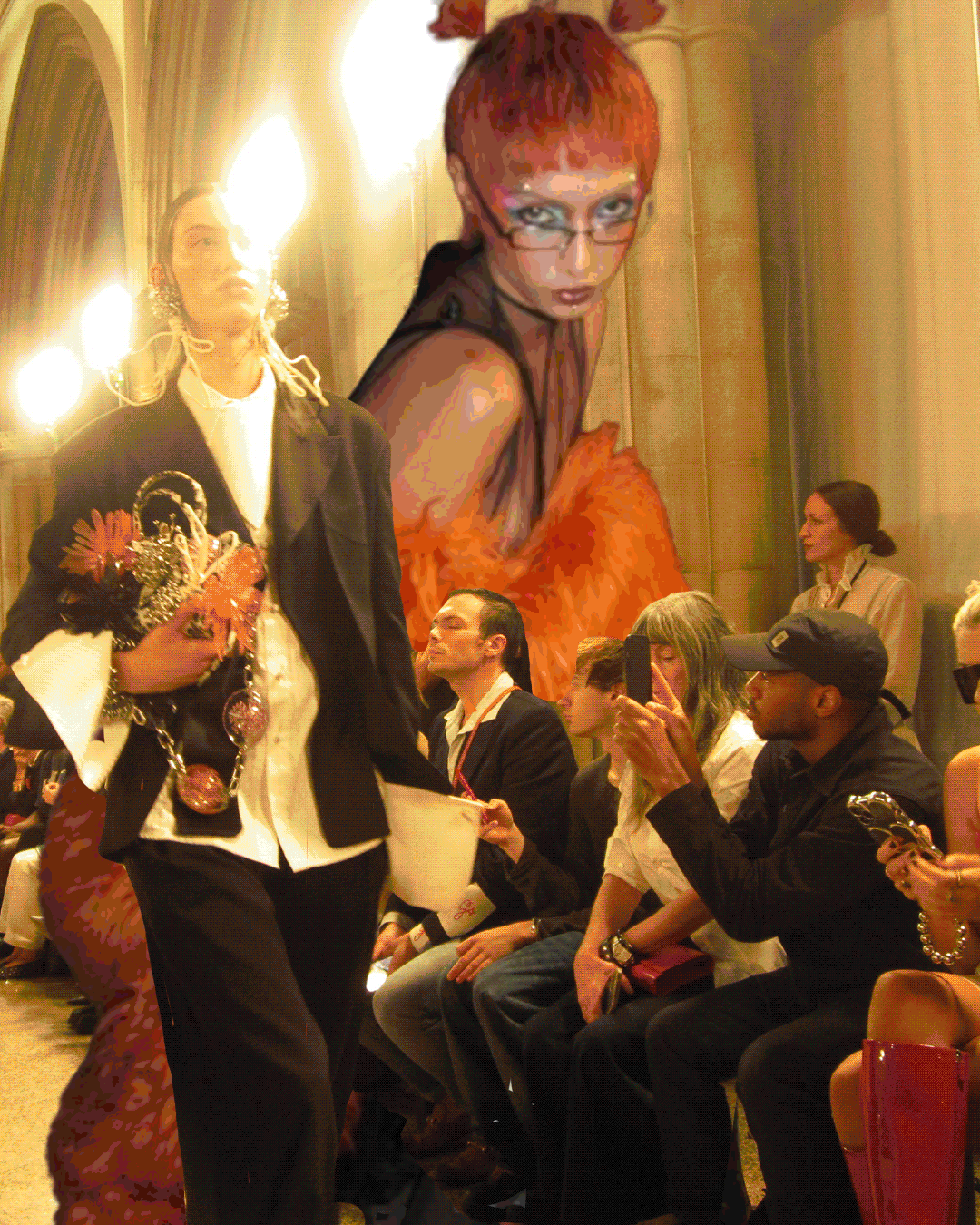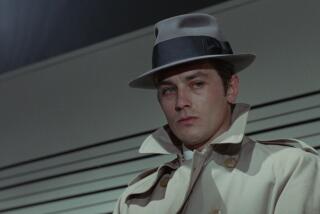Savage Laughter
- Share via
David Sweetman juggles history adroitly. “Explosive Acts” undertakes a triple biography grafted onto a running anecdotal history of the last two decades of the 19th century in Paris. Like its title, the book relishes hyperbole. Toulouse-Lautrec comes on stage with an aura of controversy and outrage shimmering around him. Oscar Wilde and the less known Felix Feneon are included as “only the most shocking of a host of fascinating characters that Lautrec knew and worked with.” Sweetman calls Wilde “a notorious homosexual” and Feneon “a violent revolutionary and terrorist.” When Sweetman settles down to give narrative shape to his far-reaching investigations into the period, he moves beyond these opening flourishes and produces a hearty serving of social and political history. Earlier biographies of Gauguin and Van Gogh have given him unlimited access to the fin de siecle.
“Explosive Acts” paints once again the stunted (less than 5 feet), bandylegged, liver-lipped aristocrat who by age 25 transplanted himself into a resolutely bohemian life. His posters and paintings soon gained recognition as being among the most vivid expressions of the cabaret-brothel world of Montmartre. He both observed the dissolute high jinks and, despite his handicaps, enthusiastically participated in them--to the point of helpless alcoholism, probable syphilis and temporary confinement in a mental institution. Two strokes carried him off in 1901, not yet 37. Sweetman constructs lively portraits of Lautrec’s still-famous companions from the Montmartre entertainment world: the singers Bruant, Jan Avril and Yvette Guilbert, and the dancer La Goulue. The second chapter does a responsible job of tracing Lautrec’s anti-Impressionist, rakishly tilted, studiously candid compositions to their origins in Daumier, Vernet, Forain and Degas. Both the first and the last were greater artists than Lautrec, but in his brief working career of 15 years, he created a style of fast-paced elliptical grotesqueries that has left a persistent afterimage.
Lautrec was fascinated by Wilde as the combined figure of prisoner, outcast and aesthete. Sweetman treats as a certainty the probability that they met in both London and Paris. Because Sweetman includes only a bibliography, with no notes or sources, some of his stories float free in the redolent anecdotal sauce of the period. He repeats the old chestnut about Lautrec placing his brothel works in a locked room at his first one-man show in 1896. But he produces no firm evidence and, without that, I keep faith with Lautrec’s judicious earlier biographer, Julia Frey. She doubts the story. Her “Toulouse-Lautrec: A Life” (1994) does not credit unverifiable anecdotes, however colorful.
Lautrec also had many reasons to admire Feneon, an astute art critic who praised his work, a militant anarchist (who probably did detonate a near-fatal bomb in a restaurant opposite the Senate) and the savvy editor of La Revue Blanche. The reason, however, for giving Wilde and Feneon major roles in this searching study of Lautrec is not that the three of them formed an inseparable band of Montmartre Musketeers but that they offer us contrasting probes into the fin de siecle. Through Feneon, Sweetman gives a fuller account of anarchism than is normally the case in such books. The subject is often neglected. Among many artists and intellectuals, anarchism benefited from the allure of radical chic. Having spent time in prison and having defended himself with impressive calm during a widely publicized trial, Feneon was released and gained considerable notoriety. He had a true gift for recognizing and encouraging artistic talent. At the same time, a dark fanaticism drove his political behavior. He decided to become a communist after the worst excesses of the Soviets under Stalin.
Sweetman deftly keeps all these balls in the air, plus many more. There’s a reliable narrative of the opening of Alfred Jarry’s near-obscene play, “Ubu Roi” in 1896. Lautrec collaborated on the improvised sets. And because Lautrec included Dr. Fournier in a late painting, Sweetman puts together a four-page digression on the doctor’s dedicated research on syphilis when the disease was reaching crisis proportions in Europe. But Sweetman manages to catch these flying fragments just in time and to lead us back to Lautrec’s dazzling and disastrous career. With its exceptional cast of three principal characters, plus all the Montmartre performers given roles in John Huston’s 1952 movie “Moulin Rouge,” “Explosive Acts” provides a partially fresh view of a familiar scene.
Let me fall back a pace or two to raise the question of why someone with Sweetman’s experience would devote time to such a book. What are his essential materials? Explosive acts, says the sign on the door: Lautrec’s artistic gifts overcoming his physical handicaps and then his rapid succumbing to a life of drink, brothels and cabarets. Wilde’s first denied, then defiant, homosexuality. Feneon’s secretive terrorism. A chapter on the wave of public lesbianism in Montmartre. An unrelenting concern with “night people.” And, finally, two drunken playful shameless photographs Lautrec had someone take of him with his pants down and a grin on his face, defecating on the Normandy beach. What are we to make of them?
Almost every element of the book focuses on outrageous behavior. The accumulation of shocking incidents leads me to conclude that this project has been undertaken in large part because it feeds a widespread prurient interest in cultural excess and unrestrained transgression of social constraints. And where does it all lead? On the one hand, the constant dissoluteness points fatefully toward “impending collapse” of the fin de siecle mood. On the other hand, these excesses “led French radical art into the modern age” and cast Lautrec in the role of “the harbinger of the century to come.” Neither conclusion is adequate.
Isn’t Sweetman just grinding out another slightly refurbished version of bohemia? There lies the golden underground about which musicians compose famous operas and to which we all declare fealty at some self-indulgent stage of our life. Yes, he has, without using the word, embraced the utopian myth of bohemia. He acknowledges the desperation and solitariness it sometimes brings and then goes on to imply that all its depredations can be redeemed by the irrepressible high spirits of lowlife. He refers to Paris as “the city of ferment and change, where districts like Montmartre excited such a powerful influence on anyone connected with the creative life.” “Feneon, Jarry, and [Lautrec] delighted in creating paradox. . . . [T]hey introduced a ferocious kind of humor . . . that answers the questions so often raised about Lautrec’s inconsistencies.” In bohemia, savage laughter trumps common sense and morality. Sweetman turns his back on much greater artists such as Mallarme and Vuillard, who did not need or seek the bohemian maelstrom.
Given the popular and commercial appeal of these wild stories, we shall not soon detach ourselves from the romantic notion that the most zesty and genuine art will arise out of cultivated excess: drink, drugs, licentious sex, revolutionary politics, violence and madness. Even Van Gogh has been drawn into that planetary system. For he hung out in cafes, went mad and committed suicide. But Van Gogh was not a true bohemian, not an aristocrat slumming at the Moulin de la Galette, not a bourgeois sowing his wild oats in an artist’s beret. He makes a cameo appearance in “Explosive Acts,” but he doesn’t belong here. Van Gogh had a genuine spiritual calling and a deep commitment to the poor peasants and coal miners he painted. For him, the craziness and anarchy of bohemia are not the source of true art.
Sweetman’s book revels in the rowdy episodes he narrates and perpetuates the magic glow of Montmartre in its heyday. However, he does not hide the fact that the arts it produced were often sponsored by owners and managers who made a tidy profit on the myth of bohemia. And he gives an unsparing account of the miserable bitter end to which Lautrec and Wilde both finally came.
More to Read
Sign up for our Book Club newsletter
Get the latest news, events and more from the Los Angeles Times Book Club, and help us get L.A. reading and talking.
You may occasionally receive promotional content from the Los Angeles Times.






